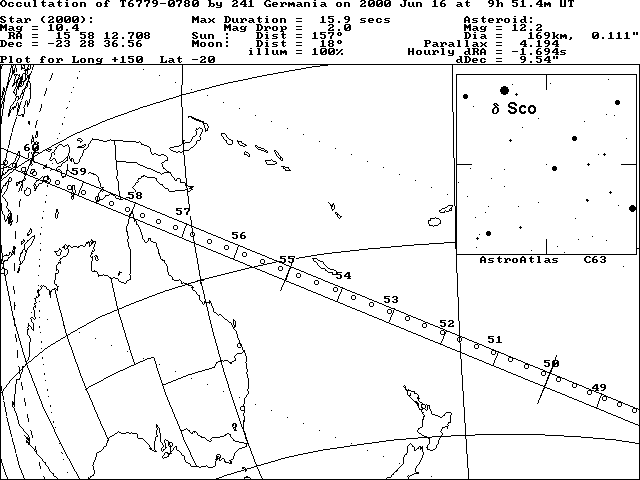ASTROMETRIC UPDATE:
OCCULTATION BY (241) GERMANIA - 2000 JUNE 16
THIS UPDATE REPLACES THE PREVIOUS UPDATE OF 10 JUNE.
CHECK THIS PAGE REGULARLY FOR FURTHER UPDATES AND CHANGES TO THE TRACK.
YOU MUST RELOAD THIS PAGE USING YOUR BROWSER'S
RELOAD/REFRESH BUTTON TO OBTAIN UPDATES!
[Prediction by Edwin Goffin]
[Prediction using OCCULT software]
[Detailed finder chart by Jan Manek]
Goffin's path runs well to the north of the North Island of New Zealand, just to the south of New Caledonia and clips the far nothern portion of the Cape York Peninsula. The path given by OCCULT lies around 0.5 of a path width to the north-east with little difference in time.
UPDATE: 13 June 2000
This prediction update has been computed by Jan Manek of the Stefanik Observatory based on astrometry from Ron Stone of the US Naval Observatory - Flagstaff Station and Bill Owen of Table Mountain Observatory. The Tycho-2 position of the target star has been used.
Summary:
This update places the new path around 0.5 of a path width to the north-east and 30 seconds later than that given by Edwin Goffin. The path passes around 1 path width to the south-west of New Caledonia (9:54 UT) before crossing the Coral Sea. The most northern tip of the Cape York Peninsula is included (9:58 UT), as are the southern most portions of Irian Jaya and the eastern islands of Indonesia.
Observers may have some difficulty locating the target star due to it being only 18 degrees from the full moon.
THE EVENT AT ONE GLIMPSE:
- Date and approx. UT time of event: June 16, 2000 @ 9:58 UT
- Magnitude of target star: 10.4
- Magnitude drop [mag]: 2.0
- Estimated maximum duration [s]: 15.9
- Path description: See above.
- Goffin's original chart reference: A00_0613
The Occultation Path:
- Approximate width [km]: 175
- Uncertainty [path widths]: 1.2
- Uncertainty in time [s]: 20
- Map: See below
- Remarks: Uncertainities are given on the basis of the nominal star position errors and the expected asteroid positional accuracy.
- Circles along the path are OCCULT calculated exact centerline points.
Data for the target star:
Data for the minor planet:
- Number, name: (241) Germania
- Approx. diameter [km]: 169
- Source of used astrometry: US Naval Observatory - Flagstaff Station (Ron Stone), TMO (Bill Owen)
- Number of used observations: 50 USNO, 5 TMO
- Number of rejected observations: 8 USNO
- Time covered by the observations: 1998 02 12 - 2000 06 09
- RMS residuals ["] (RA,DE): 0.07", 0.10"
- Estimated positional accuracy at epoch of event ["]: 0.09"
Data for the event:
- UT date and time of least geocentric approach: 2000 June 16, 9:51.4 UT
- Approx. V mag of minor planet at event [mag]: 12.2
- Geocentric parallax of minor planet ["]: 1.194
- Magnitude drop [mag]: 2.0
- Estimated maximum duration [s]: 15.9
- Apparent motion of minor planet ["/h]: 25.17
- Angular distance to moon, phase of moon [deg,%]: 18, 100%
- Update computed by: Jan Manek, Stefanik Observatory, Prague, Czech Republic.

IMPORTANT NOTE!
Astrometric updates such as these should not be taken as definitive, but rather only as an indication of where the true track may lie relative to the original predicted track. Observers must bear in mind that later astrometry, in which the target star is measured in the same field as the asteroid, may still reveal substantial changes to the predicted track and time of the event. For this reason it is most important that observers far from the predicted track still monitor the event.
Use these links for further information:
[Planetary Occultations]
[Using the Predictions]
[Observing Details]
[Timing Details]
[Reporting Details]
[Report Form]
[Asteroid Occultation Results]
This page may have been updated since 13 June 2000.
Hit your browser's RELOAD button to get the latest version.
[Site Map]
[What's an Occultation?]
[Total Occultations]
[Grazing Occultations]
[Planetary Occultations]
[Jovian Satellite Eclipses]
[Timing Occultations]
[Reporting Observations]
[Coming Events]
[Software]
[About Us]
[Publications]
[Membership]
[Links]
[Top of Page][Return to Home Page]
